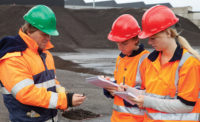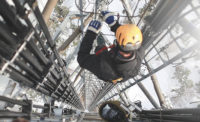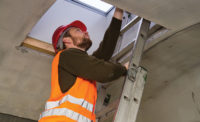Forklift operators maneuver four ton (or more) machines through aisles, over dock boards, into trailers, between racks, near pedestrians, on ramps and sometimes in hazardous environments. They cover a lot of territory even if the forklift never leaves the confines of a warehouse.
Not only does OSHA have regulations for the forklifts themselves, they also have specific requirements for forklift operators. The Powered Industrial Truck Standard outlines the topics that must be included during training, as well as requirements for refresher trainings.
One element of this required training that is sometimes overlooked is the requirement to address “other unique or potentially hazardous environmental conditions in the workplace that could affect safe operation” [29 CFR 1910.178(l)(3)(ii)(I).] Of course, some of these hazards will truly be “unique” to a facility, but several of these more common standards may be applicable to forklift operators.
DOT hazmat employee
Facilities that offer hazardous materials for shipment must comply with Department of Transportation (DOT) regulations as well as OSHA regulations. Forklift operators are considered “hazmat employees” if they are involved with:
- Determining hazard classes, filling out shipping papers or providing placards.
- Selecting hazmat packaging or packing materials into bulk or non-bulk packaging.
- Selecting modes of transportation.
- Loading, blocking or bracing hazmat packaging into a transport vehicle.
- Adding labels or markings to containers to indicate hazardous contents or securing closures on hazardous materials packages or containers.
Hazmat employees must complete a general awareness training to familiarize them with the hazards that are present in the materials being shipped, safety training to minimize risks while handling the hazardous materials, security awareness training and function specific training. Hazmat employees must be tested and certified prior to performing any hazardous material packaging function and must attend refresher trainings at least every three years [49 CFR 172.704.]
Walking working surfaces
Condensation, leaks, drips and spills create slip and fall hazards on walking surfaces. But for forklift operators who are accustomed to working in predominately dry environments, these hazards can be compounded by inadequate lighting and because they are easily overlooked; especially when climbing onto or off of forklifts.
Train workers to look for leaks and spills before stepping onto the step of the forklift or onto the floor. Care should also be taken in battery charging areas where electrolyte is topped off, near loading docks and at man doors that allow rain or snow to enter.
Operators who pick orders at elevations need to be taught how to prevent falls from heights. This training may include the use of safety harnesses, lanyards and other protective devices. Workers may also need to be protected from falling objects. [29 CFR 1910.28-.30.]
Emergency action plans
Many facilities are required to have Emergency Action Plans. These plans assess hazards in and around the facility, and outline the procedures for all employees to report emergencies and evacuate the building.
In some facilities, a forklift operator may perform an operation or other response duty before evacuating. An example of this would be using a forklift to transport spill response supplies to spill responders before evacuating – if it is safe for them to do so.
Operators who will perform “critical plant operations,” rescue or medical functions must be specifically trained to perform these duties safely [29 CFR 1910.38.] They should also be included in response drills so that they have opportunities to practice performing any tasks expected of them during an emergency.
Personal protective equipment
It’s not always possible to eliminate every hazard that a forklift operator could face with engineering or administrative controls. Personal Protective Equipment (PPE) is the last line of defense to decrease risk. When PPE is required, operators must be trained to wear and use it correctly. They must also be taught about limitations, care and disposal of the PPE at the end of its useful life [29 CFR 1910.132(f)].
About 30% of workplace injuries involve cuts; and about 70% of those injuries are to the fingers or hands. Implementing a hand protection program that includes the use of safety knives when cutting boxes, tape or strapping; as well as providing gloves that protect the hands from both cuts and abrasion can help reduce these risks [29 CFR 1910.138.]
Foot injuries also continue to be common – and easily avoidable with the correct footwear [29 CFR1910.136]. Each year, with more than 60,000 workers experience crushed toes, broken feet, amputations and other foot injuries. About 80% of these injuries are caused by falling objects that weigh less than 30 pounds. The other 20% include punctures through the sole of the foot and being run over by wheels or pallet jacks, according to the Bureau of Labor Statistics.
Employees who could be struck by falling objects will also need a “protective helmet” that meets ANSI requirements [29 CFR 1910.135]. Hazard assessments may uncover other PPE needs, such as respiratory or electric shock protection.
Control of hazardous energy
Like all machines and equipment, forklifts need to be serviced and maintained from time to time. Establishing and enforcing lockout/tagout procedures will help to protect employees working on the equipment as well as others in the area from being harmed in the event of the equipment starting unexpectedly [29 CFR 1910.147.]
Training should include procedures for how and when to lockout a forklift. Instruction should include how to use lockboxes to isolate power connections because removing the key from the ignition does not isolate the energy source.
Ergonomics
Sprains and strains are consistently the top cause of lost worktime injuries in the United States. Although OSHA does not have an ergonomics standard, they do recognize lifting heavy items, reaching overhead, bending, pushing and pulling heavy loads, repetitive motion tasks and working in awkward body postures as “recognized hazards” in the workplace.
Because these are recognized hazards under the general duty clause, employers must assess them and look for ways to reduce the risk they present. When engineering controls are not enough to control the hazards, administrative and work practice controls may help.
Training in administrative and work practice controls can include teaching employees to stretch before their shift, work in pairs when lifting heavy objects, using proper lift techniques, use of carts and hand trucks to move loads instead of physically carrying items, and the proper use of tools and equipment that are available to assist them with lifting and handling tasks.
The training elements in OSHA’s powered industrial truck standard help to ensure that material handling employees operate forklifts in a safe manner. Incorporating other safety standards into their training helps them to be better prepared to recognize other hazards associated with their job tasks, which can help reduce the risk of injuries and deaths among forklift operators.



